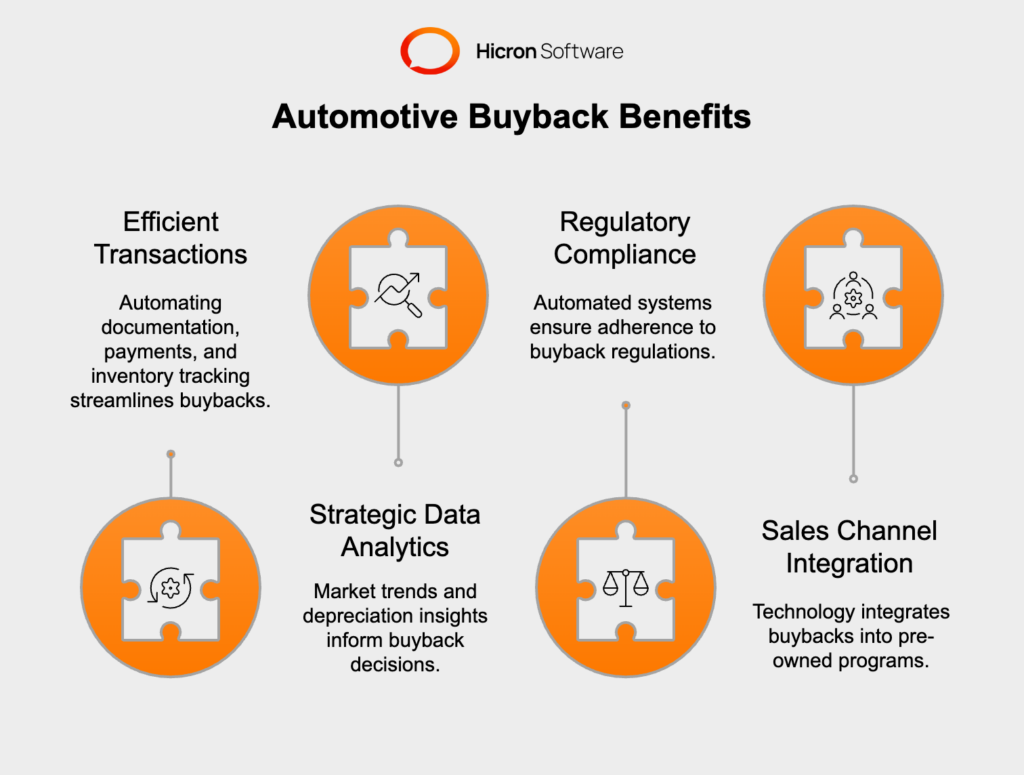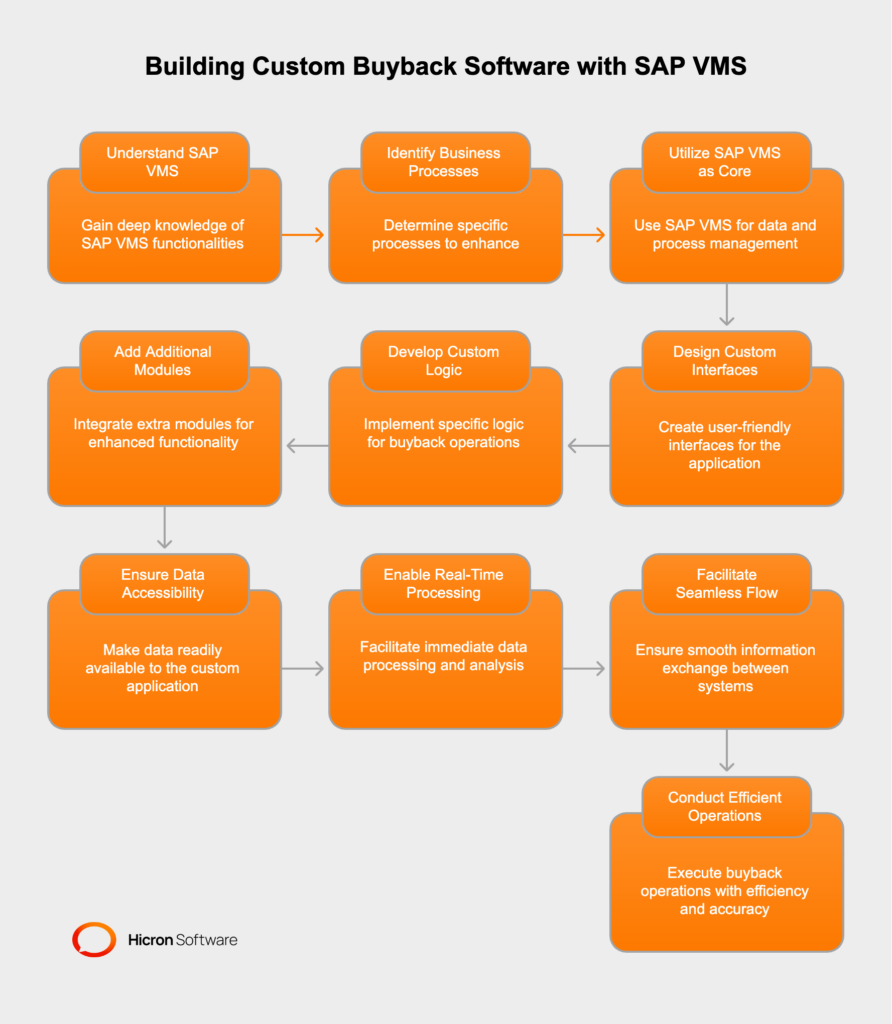Creating Unified Automotive Experience: The Role of Tailored Front-Ends
- March 05
- 14 min

In the automotive industry, an auto buyback program often refers to a manufacturer purchasing vehicles from dealerships or consumers. Unlike lemon buybacks, which are driven by product quality issues, these transactions can be strategic moves aimed at managing inventory, stabilizing prices, or supporting the used car market. Here’s a concise overview of the rationale behind automotive buybacks and the critical role of streamlined processes and buyback software in their execution.
Automotive buybacks serve several strategic purposes, each contributing to the broader business objectives of manufacturers and dealers:
The complexity and scale of automotive car buybacks necessitate efficient management systems. Streamlined processes and buyback software are indispensable for several reasons:

Custom buyback software offers a tailored solution to meet these needs, particularly in sectors such as automotive, where car buyback programs are a strategic component of inventory and brand management.
Unlike off-the-shelf software solutions, custom buyback software is built from the ground up to accommodate the particular preferences, expectations, and workflow of a business. This bespoke approach ensures that every feature and functionality serves a purpose, directly contributing to operational efficiencies and strategic objectives.
Custom vehicle buyback software can transform the buyback process by providing tailored solutions that address the specific challenges and goals of a business. Here are several benefits of using custom software in managing automotive buybacks:
In the dynamic world of the automotive industry, managing complex processes such as inventory, sales, and especially buybacks efficiently is crucial for maintaining a competitive edge and ensuring customer satisfaction. Vehicle Management System (VMS) emerges as an indispensable solution, offering comprehensive functionalities tailored to meet these industry-specific challenges. Let’s take a look at the overview of SAP VMS, its core functionalities, and explore the pivotal advantages it offers as a backend system in managing buybacks, highlighting the necessity for customization to address specific needs.
SAP VMS stands as a specialized module within the broad SAP ecosystem, designed to cater to the automotive sector’s nuanced demands. It aims to streamline the entire vehicle lifecycle management – from production and distribution to sales, including the intricate processes of buybacks. By integrating seamlessly with other SAP modules, it ensures a cohesive and efficient operational flow across various departments.
Key functionalities of SAP VMS include:
While SAP VMS provides a robust framework for automotive management, leveraging it as a backend system for vehicle buyback management — especially with customized enhancements — unveils noteworthy advantages. These advantages become even more pronounced when addressing the often-overlooked area of vehicle buybacks, where specific functionalities may not be inherently present in standard configurations.
The confluence of custom software development with SAP Vehicle Management System (SAP VMS) as a backend infrastructure. The essence of this custom VMS integration lies in leveraging the robust, scalable, and secure environment provided by SAP VMS, while simultaneously introducing the agility, customization, and specific functionality offered by bespoke software solutions. This approach enables businesses to craft applications that are not only perfectly aligned with their unique operational needs but also benefit from the reliability and comprehensive capabilities of SAP’s system.
Custom VMS integrations in the automotive industry are tailored solutions designed to connect vehicle management systems with business-specific processes. By customizing these integrations, dealerships and manufacturers can streamline operations, automate workflows, and address unique challenges like inventory tracking, customer relationship management, or reporting. This ensures greater efficiency, reduces manual errors, and allows businesses to adapt quickly to evolving market demands. Tailored VMS integrations empower automotive companies to deliver better service while optimizing internal processes.
Building custom buyback software atop SAP VMS requires a deep understanding of both the platform’s extensive functionalities and the specific business processes it aims to enhance. The development process involves utilizing SAP VMS as the core database and process management system, around which custom interfaces, logic, and additional modules are designed. This symbiotic relationship ensures that all transactional data, customer information, and vehicle lifecycle details managed within SAP VMS are readily accessible to the custom application, enabling real-time data processing, analysis, and decision-making. This architecture facilitates a seamless flow of information between SAP VMS and the custom application, ensuring that all buyback operations are conducted with utmost efficiency and accuracy.

The impact of deploying custom buyback software built on VMS (Vehicle Management System) as a backend for managing repurchase processes is profound. It allows for creating highly specialized workflows and user interfaces tailored to the nuances of auto buyback transactions, which can significantly enhance operational efficiency and user experience. Employees can navigate the complexities of automotive buyback operations more intuitively, reducing processing times and increasing productivity.
This approach grants businesses the flexibility to rapidly adapt to changing market conditions, regulatory requirements, and business strategies. Custom buyback software can be quickly updated or extended to incorporate new functionalities, ensuring the buyback process remains optimal under varying circumstances.
The integration of custom analytics and reporting tools into the buyback management system empowers businesses with actionable insights derived from comprehensive data analysis. By tapping into the vast reservoir of data housed in VMS, companies can identify trends, predict market movements, and make informed decisions that enhance the profitability and effectiveness of their buyback programs. This data-driven strategy not only improves the immediate operational aspects of buybacks but also contributes to long-term strategic planning and competitive positioning.
Utilizing custom buyback software with SAP Vehicle Management System (SAP VMS) as a backend infrastructure offers businesses a strategic advantage in achieving their objectives. This approach provides the flexibility and specificity of custom solutions tailored to address unique business needs. By marrying the strengths of VMS with custom software for automotive, businesses can enhance operational efficiency without multiplying technological debt.
This results in considerable time and cost savings. Digitization of the process and in-house adaptation reduce manual labor and minimize errors.
Custom vehicle buyback solutions utilizing an existing VMS system as a backend can provide advanced analytics and reporting features, offering valuable insights into potential trends, customer behaviors, and operational performance.
These insights empower decision-makers to formulate data-driven strategies, adjust to market demands swiftly, and identify opportunities for growth and improvement.
Implementing custom buyback software solutions atop an existing system like SAP VMS can be challenging. One potential hurdle is ensuring seamless integration between the custom buyback software and SAP VMS, which requires a deep understanding of both systems and the use of appropriate tools and protocols. Businesses may also face data security and compliance issues, as integrating new software with an existing system introduces complexities in managing sensitive information.
To overcome these challenges, businesses should adopt a meticulous planning and execution strategy. This includes conducting thorough requirements analysis, choosing experienced development and integration partners, and implementing quality assurance processes. Additionally, adopting best practices for data security and compliance, such as encryption, access controls, and regular audits, can help mitigate risks associated with data management.
Businesses should invest in comprehensive training programs for their staff to ensure smooth adoption and maximize the integrated system’s benefits. Educating employees on the new system’s functionalities, benefits, and best practices can enhance user adoption and operational efficiency.
As we look towards the future of buyback software, it’s evident that technology will play an increasingly pivotal role in shaping its evolution. The automotive industry, among others, is on the cusp of significant transformation, driven by advancements in software solutions, data analytics, and customer engagement platforms. These technological innovations will streamline auto buyback processes and redefine the strategic importance of automotive buybacks in business models. Here, we explore predictions about future buyback software and management trends and offer advice for businesses aiming to stay competitive in this dynamic landscape.
Get an Expert perspective on the subscription model is the automotive:
Access the full conversation here.
In summary, leveraging custom buyback software with Vehicle Management System (e.g., SAP VMS) as a backend is a pivotal strategy for businesses seeking to streamline their buyback processes without incurring additional costs. This approach offers a bespoke solution that aligns with specific business needs and objectives, marrying the flexibility of custom software with the robustness of VMS.
The integration facilitates enhanced efficiency, agility, and customer satisfaction, enabling companies to adapt swiftly to market demands and regulatory changes. It not only optimizes operational processes but also provides a competitive edge in an increasingly crowded marketplace. Businesses can achieve significant improvements in inventory management, operational efficiency, and customer loyalty, all while keeping costs in check.
See an example of how we used the SAP VMS backend for Car Configuration Management
Ultimately, using custom software with SAP VMS for buybacks is more than a technical upgrade—it’s a strategic investment in the future success of the business. It positions companies to not only meet current challenges but also to capitalize on future opportunities, ensuring long-term growth and sustainability. Get in touch to discuss further!
